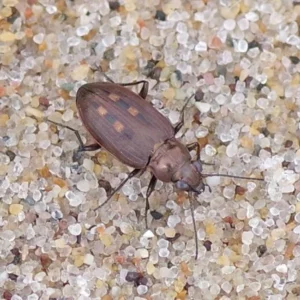Note: All links leave to external sites.
Greetings, BugFans,
The Ground beetle family (Carabidae) contains some large and spectacular species [ 1, 2, 3 ] (including the Tiger beetles), but today’s beetle is neither large nor flashy. It’s pretty fast, though.
With 2,440 species in North America and around 34,000 species worldwide, Carabidae is one of the largest insect families. Most Carabids are active hunters, both as larvae and adults, and many species (but not the tiger beetles) are nocturnal. Other than that, Carabids come in all sizes, shapes, and colors, and habits and habitats. Many are chemically protected, with special glands where they can concoct noxious substances.
Cool fact about Ground beetles: according to bugguide.net, “the front tibia has a prominent notch (antenna cleaner) on the inside near distal end.”
The BugLady was moseying around on the beach one August day when she spied an impossibly small beetle zipping over the sand. So (of course) she aimed her camera at it as it ran around her and between her feet. Bent over, with the 100mm lens about 2 ½ feet above the sand, this was the only shot worth keeping.
She figured out that it was in the genus Bembidion (though she guessed the species wrong). Bembidion is the largest genus in the Carabidae, and it’s a complex one. Evans, in Beetles of Eastern North America, says that “Bembidion is a large genus; species sometimes challenging to identify.” There are about 1,300 described species that are divided among about 100 subgenera, with more in the pipeline. About 250 species live in North America, eight of them non-native.
As a group, they are small (a half-inch or less), slender and somewhat flattened, dark and often metallic, speedy denizens of habitats near the water, especially river banks (though there are some grassland and desert species, too). Their range is described as (new science words) biantitropical or amphitropical – that is, they live at both southern and (mostly) northern latitudes, away from the tropics. They tend to appear on the landscape in spring and summer, they prey on tiny invertebrates, and they overwinter as adults.
The BugLady sent the picture off to BugFan PJ for his thoughts. He thought he should send it along to a ground beetle specialist, who wrote, “Kate’s culprit is likely Bembidion (subspecies Bracteon) carinula Chaudoir. See here. This is an abundant species that runs fast on wet sandy shores of Lake Michigan during warm sunlight in midsummer. They often fly when approached.” Thanks, Gentlemen – it takes a village.
Most of the few sources of information that she found didn’t list a common name, but the Canadian NWT Species Search website calls it, logically, the Sand-loving Bembidion Beetle. Its range covers much of Canada and across the northern tier of the US into New England (with some records in Iowa, Kentucky, and New Jersey). It’s seen on sparsely-vegetated shores, often on dry sand, and though it’s not uncommon, it may be hard to see because it’s only 3/8” in length and it moves along like the Roadrunner. It’s active during the day, and the adults are good fliers.
The checkerboard pattern on its elytra is more conspicuous in some individuals than in others.
Other than the fact that it appears on a number of “The Ground Beetles of (Wherever)” surveys and checklists, and it’s a species of Special Concern on Connecticut, there’s not much out there about Sand-loving Bembidion beetles. As always, several sites offered to tell the BugLady what words rhyme with Bembidion, and yes, you can order a Bembidion beetle Sun catcher and a belt buckle online.
The BugLady
